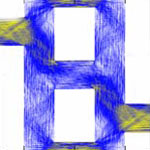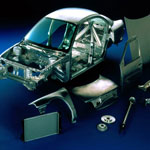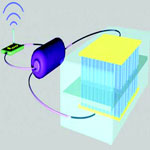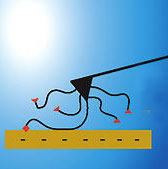Showing Spotlights 129 - 136 of 203 in category All (newest first):
 Researchers have demonstrated that electrons in nanoscale networks can behave like car drivers in congested cities. Traffic planners are sometimes faced with a rather counter-intuitive observation - adding a new road to a congested road network can lead to a deterioration of the overall traffic situation, i.e. longer trip times for individual road users. Or, in reverse, blocking certain streets in a complex road network can counter-intuitively reduce congestion. This has become known as the Braess paradox. Researchers have now applied the concept of the Braess paradox to the quantum world. By combining quantum simulations of a model system and scanning-probe experiments, they have shown that an analogue of the Braess paradox can occur in mesoscopic semiconductor networks, where electron transport is governed by quantum mechanics. The paradox manifests itself by an increase of the conductance network when one arm in the network is partially blocked in a controlled manner.
Researchers have demonstrated that electrons in nanoscale networks can behave like car drivers in congested cities. Traffic planners are sometimes faced with a rather counter-intuitive observation - adding a new road to a congested road network can lead to a deterioration of the overall traffic situation, i.e. longer trip times for individual road users. Or, in reverse, blocking certain streets in a complex road network can counter-intuitively reduce congestion. This has become known as the Braess paradox. Researchers have now applied the concept of the Braess paradox to the quantum world. By combining quantum simulations of a model system and scanning-probe experiments, they have shown that an analogue of the Braess paradox can occur in mesoscopic semiconductor networks, where electron transport is governed by quantum mechanics. The paradox manifests itself by an increase of the conductance network when one arm in the network is partially blocked in a controlled manner.
Feb 21st, 2012
 This article summarizes the progress, products outlook, advantages, and limitations of nanocomposites in the automotive industry. Polymer nanocomposites represent a new class of multiphase materials containing dispersion of nano-sized filler materials such as nanoparticles, nanoclays, nanotubes, nanofibers etc. within the polymer matrices. Owing to their nanoscale size features and very high surface-to-volume ratios, they possess unique combination of multifunctional properties not shared by their more conventional composite counterparts reinforced with micro-sized fillers. These multifunctional nanocomposites not only exhibit excellent mechanical properties, but also display outstanding combination of optical, electrical, thermal, magnetic and other physico-chemical properties.
This article summarizes the progress, products outlook, advantages, and limitations of nanocomposites in the automotive industry. Polymer nanocomposites represent a new class of multiphase materials containing dispersion of nano-sized filler materials such as nanoparticles, nanoclays, nanotubes, nanofibers etc. within the polymer matrices. Owing to their nanoscale size features and very high surface-to-volume ratios, they possess unique combination of multifunctional properties not shared by their more conventional composite counterparts reinforced with micro-sized fillers. These multifunctional nanocomposites not only exhibit excellent mechanical properties, but also display outstanding combination of optical, electrical, thermal, magnetic and other physico-chemical properties.
Jan 11th, 2012
 Naturally occurring nanomaterials can be found everywhere in nature and only with recent advances in instrumentation and metrology equipment are researchers beginning to locate, isolate, characterize and classify the vast range of their structural and chemical varieties. Scientists are beginning to recognize that all sources of nanomaterials are important in evaluating the possible impact of nanoscale materials on human health and the environment; however, perhaps the greatest benefit to studying these materials will be in their ability to inform researchers about the manner in which nano-sized materials have been a part of our environment from the beginning.
Naturally occurring nanomaterials can be found everywhere in nature and only with recent advances in instrumentation and metrology equipment are researchers beginning to locate, isolate, characterize and classify the vast range of their structural and chemical varieties. Scientists are beginning to recognize that all sources of nanomaterials are important in evaluating the possible impact of nanoscale materials on human health and the environment; however, perhaps the greatest benefit to studying these materials will be in their ability to inform researchers about the manner in which nano-sized materials have been a part of our environment from the beginning.
Nov 24th, 2011
 Colloidal silver is not a health elixir and should not be taken orally. Still, dubious online resources that sell silver dispersions or explain how to synthesize colloidal silver for nutritional purposes keep propagating mystic health effects of nano-silver. Whoever considers to "treat" themselves by taking colloidal silver certainly don't know what they want to treat themselves for. They should be aware that drinking an antimicrobial agent at any effectual dosage must inevitably cause harm to innumerable bacteria that are vital to our organism - especially in the alimentary canal. Drinking colloidal silver will either be noneffective or harmful. It is not medicine.
Colloidal silver is not a health elixir and should not be taken orally. Still, dubious online resources that sell silver dispersions or explain how to synthesize colloidal silver for nutritional purposes keep propagating mystic health effects of nano-silver. Whoever considers to "treat" themselves by taking colloidal silver certainly don't know what they want to treat themselves for. They should be aware that drinking an antimicrobial agent at any effectual dosage must inevitably cause harm to innumerable bacteria that are vital to our organism - especially in the alimentary canal. Drinking colloidal silver will either be noneffective or harmful. It is not medicine.
Nov 4th, 2011
 Today we are going to tackle a general topic that deals with how data is represented in scientific papers. The use of illustrations in scientifi c publications is a longstanding tradition that goes back thousands of years. In the course of writing 1,200 Nanowerk Spotlights over the past six years, we have worked our way through thousands of papers. And if one thing has stood out, it is the quality of the illustrations included in these papers: some are just excellent and capture the essence of the findings; others, well, let's just say they could be improved upon. Here are five specific recommendations on how scientists should design effective figures.
Today we are going to tackle a general topic that deals with how data is represented in scientific papers. The use of illustrations in scientifi c publications is a longstanding tradition that goes back thousands of years. In the course of writing 1,200 Nanowerk Spotlights over the past six years, we have worked our way through thousands of papers. And if one thing has stood out, it is the quality of the illustrations included in these papers: some are just excellent and capture the essence of the findings; others, well, let's just say they could be improved upon. Here are five specific recommendations on how scientists should design effective figures.
Sep 22nd, 2011
 It is quite difficult - not least because there is no consensus about a proper definition - to assess the scope of nanotechnology research and its impact on the overall scientific body as well as its commercialization prospects. In a new attempt to put some numbers behind the general perception of a rapidly expanding nanotechnology field, two researchers at UC Davis have trawled scientific databases and come up with some surprising findings. For instance, that China has now overtaken the USA in annual research paper output related to nanoscience and nanotechnology. Also, the proportion of "nano"-related articles relative to the total size of the subject categories (such as physics, materials sciences or chemistry) has risen dramatically over the past 13 years.
It is quite difficult - not least because there is no consensus about a proper definition - to assess the scope of nanotechnology research and its impact on the overall scientific body as well as its commercialization prospects. In a new attempt to put some numbers behind the general perception of a rapidly expanding nanotechnology field, two researchers at UC Davis have trawled scientific databases and come up with some surprising findings. For instance, that China has now overtaken the USA in annual research paper output related to nanoscience and nanotechnology. Also, the proportion of "nano"-related articles relative to the total size of the subject categories (such as physics, materials sciences or chemistry) has risen dramatically over the past 13 years.
Aug 23rd, 2011
 Fabrication of a single nanodevice is no longer the state of the art in nanotechnology. The leading edge - and also currently the most challenging area in nanotechnology - is research that leads to a self-powered nanoscale system that is driven by the energy harvested from its environment and that can perform its work independently and sustainable. This is a key step toward self-powered nanotechnology, which is vitally important for medical science, environmental monitoring, defence technology and even personal electronics. A research team has now provided the first demonstration that a nanogenerator can be strong enough to power a device with the capability of sensing, data processing and wireless data transmission. This is a powerful demonstration of the self-powered nanosystem and its potential applications.
Fabrication of a single nanodevice is no longer the state of the art in nanotechnology. The leading edge - and also currently the most challenging area in nanotechnology - is research that leads to a self-powered nanoscale system that is driven by the energy harvested from its environment and that can perform its work independently and sustainable. This is a key step toward self-powered nanotechnology, which is vitally important for medical science, environmental monitoring, defence technology and even personal electronics. A research team has now provided the first demonstration that a nanogenerator can be strong enough to power a device with the capability of sensing, data processing and wireless data transmission. This is a powerful demonstration of the self-powered nanosystem and its potential applications.
Jun 1st, 2011
 Glues adhere to solid materials via a multitude of fundamental physical or chemical interactions. Either chemical reaction times or solvent evaporation rates determine the point in time, when this interaction sets in and fixes the object to be glued. Electric potential has been used to attract polymers continuously to an electrode surface and to toggle molecules between states for a molecular switch. If you wanted to create electric glue, you would need to be able to control the interaction of a polymer and an electrode surface reversibly, thus creating a nanoscale system with electrochemically controlled adhesion. A research team now describes how Coulomb forces between polymers and surfaces may be measured, controlled, and manipulated.
Glues adhere to solid materials via a multitude of fundamental physical or chemical interactions. Either chemical reaction times or solvent evaporation rates determine the point in time, when this interaction sets in and fixes the object to be glued. Electric potential has been used to attract polymers continuously to an electrode surface and to toggle molecules between states for a molecular switch. If you wanted to create electric glue, you would need to be able to control the interaction of a polymer and an electrode surface reversibly, thus creating a nanoscale system with electrochemically controlled adhesion. A research team now describes how Coulomb forces between polymers and surfaces may be measured, controlled, and manipulated.
May 3rd, 2011
 Researchers have demonstrated that electrons in nanoscale networks can behave like car drivers in congested cities. Traffic planners are sometimes faced with a rather counter-intuitive observation - adding a new road to a congested road network can lead to a deterioration of the overall traffic situation, i.e. longer trip times for individual road users. Or, in reverse, blocking certain streets in a complex road network can counter-intuitively reduce congestion. This has become known as the Braess paradox. Researchers have now applied the concept of the Braess paradox to the quantum world. By combining quantum simulations of a model system and scanning-probe experiments, they have shown that an analogue of the Braess paradox can occur in mesoscopic semiconductor networks, where electron transport is governed by quantum mechanics. The paradox manifests itself by an increase of the conductance network when one arm in the network is partially blocked in a controlled manner.
Researchers have demonstrated that electrons in nanoscale networks can behave like car drivers in congested cities. Traffic planners are sometimes faced with a rather counter-intuitive observation - adding a new road to a congested road network can lead to a deterioration of the overall traffic situation, i.e. longer trip times for individual road users. Or, in reverse, blocking certain streets in a complex road network can counter-intuitively reduce congestion. This has become known as the Braess paradox. Researchers have now applied the concept of the Braess paradox to the quantum world. By combining quantum simulations of a model system and scanning-probe experiments, they have shown that an analogue of the Braess paradox can occur in mesoscopic semiconductor networks, where electron transport is governed by quantum mechanics. The paradox manifests itself by an increase of the conductance network when one arm in the network is partially blocked in a controlled manner.
 Subscribe to our Nanotechnology Spotlight feed
Subscribe to our Nanotechnology Spotlight feed





